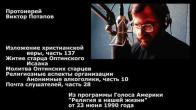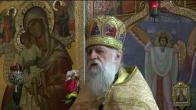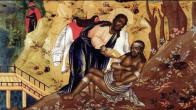ABOUT ORTHODOXY
You are here
The Parable of the Net
We find the parable of the net cast into the sea in the Thirteenth Chapter of the Gospel according to Matthew:
Again, the kingdom of heaven is like unto a net, that was cast into the sea, and gathered of every kind: which, when it was full, they drew to shore, and sat down, and gathered the good into vessels, but cast the bad away. So shall it be at the end of the world: the angels shall come forth, and sever the wicked from among the just, and shall cast them into the furnace of fire: there shall be wailing and gnashing of teeth (Matthew 13: 47-50).
The net is a symbol of the Gospel teaching, of the preaching of the Apostles, those "fishers of men". The sea is the world. The fish of every kind are the human race. This parable indicates that the net the Gospel preaching will gather together all men without distinction both good and evil, righteous and sinners. When the net is full an image of the end of time then those found in it will be divided. The good will be gathered into vessels, that is, they will be taken into the Kingdom of Heaven, while the bad will be cast away, that is, they will remain outside the Kingdom of Christ.
Between the net and God's future judgment, there is this similarity: While the fish are swimming together in the sea, it is difficult to discern their quality; but as soon as the net becomes full and is drawn to the shore, the fisherman distinguishes between the good and bad without difficulty. So also, the Church of Christ on earth (the Church Militant) consists of the most varied people of zealous Christians, who live according to God's commandments, and also of people who are negligent and simply lukewarm, that is, Christians in name only, but not in their life. While they are together, it is not easy to distinguish between them according to the quality of their spiritual life. But the final, impartial judgment of God at the end of time will without fail reveal the difference between the righteous and sinners. In His discourse on the Dread Judgment (Matthew 25:31-46), the Lord Jesus Christ speaks with utmost clarity about how this will take place.
In the other discourse, Christ says that He shall separate the righteous and the sinners one from another, as a shepherd divideth his sheep from the goats: and he shall set the sheep on his right hand, but the goats on the left. In the parable of the net, Christ likewise speaks of the separation of the good from the bad. But in contradistinction to the parable of the net, in the discourse on the Dread Judgment, Christ clearly indicates that which, namely, will first of all be asked of each one at this Judgment. All our earthly attainments will be of no account at this Judgment, for the fundamental question that will be put to each one is: How did we serve our neighbor; that is, how merciful were we toward one another? Christ enumerates six main kinds of help which one can render to his neighbor. Identifying Himself, in His love, condescension and mercy, with with every pauper and everyone in need of help, the Saviour says: For I was an hungered, and ye gave me meat: I was thirsty, and ye gave me drink: I was a stranger, and ye took me in: naked, and ye clothed me: I was sick, and ye visited me: I was in prison, and ye came unto me (Matthew 25:35-36). The Saviour sets works of mercy toward the suffering and those in need of our help higher than all else. For I desire mercy, and not sacrifice says God by the mouth of the Prophet Hosea (Hosea 6:6; see also Matthew 9:13 and 12:7).
The parable of the net and the discourse on the Dread Judgment conclude with threatening images of the punishment of sinners. In the parable of the net, it is said that the angels shall come forth, and sever the wicked from among the just, and shall cast them into the furnace of fire: there shall be wailing and gnashing of teeth; from the Lord's discourse on the Dread Judgment we know that sinners will go into everlasting fire.
The threatening image of the Dread Judgment frightens some; in others it evokes a protest, because the impression is created in them that Christ is a wrathful and condemning God. It troubles others that Christ's images of the judgment bear an exclusively physical character: sinners will be given over to torment in everlasting, unquenchable fire.
The Russian exegete, B.I. Gladkov, in his work, "Interpretation of the Gospel", remarks regarding this: "Should one understand the words furnace of fire literally, or consider that the punishment awaiting sinners is only likened to torments in a fiery furnace. It seems to us that one might understand these words literally if Jesus Christ always expressed Himself thus about the impending future of sinners; however, it is known that in other instances He expressed Himself somewhat differently: thus, in the Sermon on the Mount, He compared the torments of sinners with abiding in the valley of fire (Gehenna) (Matthew 5:29 [the original Greek has "Gehenna", which the Authorized Version translates as "hell" translator]); after that, when speaking of the lot that will befall those who have not accepted Him, He said that they shall be cast out into outer darkness: there shall be weeping and gnashing of teeth, while many shall come from the east and west and shall sit down with Abraham, and Isaac, and Jacob, in the kingdom of heaven (Matthew 8:1112). Burning in a furnace was known to Jesus' audience from the books of the Old Testament: thus, Judah, the son of Jacob, condemned his daughter-in-law Tamar to burning (Genesis 38:24); David cast into a kiln the inhabitants of the city of Rabbah whom he had subjugated (II Kings [II Samuel in the Authorized Version] 12:31);
Nebuchadnezzar ordered Ananias, Misael and Azarias, who did not worship the golden idol, to be cast into a furnace made redhot by fire (Daniel 3:21). In general, among the peoples of the East, burning alive was one of the usual forms of the death penalty, and such a penalty was the most horrible and excruciating. Therefore, Jesus Christ, when speaking of the fearful punishment of sinners in the future, eternal life, and desiring to set their fate graphically before His audience, indicated punishment in a fiery furnace as a kind of likeness of that which awaits them if they do not repent and be reborn into a new life. Later, when responding to the Sadducees on the question of the resurrection, Jesus likened people who will be resurrected for the Dread Judgment to spirits, to angels, and then He explained that the bodies of the resurrected will not be those sensuous bodies with which we are clothed during our earthly life; and from this one can conclude also that the sufferings of the condemned will rather be more spiritual than sensuous and bodily."
We repeat: It is not necessary to understand the words of Christ literally, for He expresses Himself in figurative language for the sake of greater perspicuity and vividness of depiction, which makes it easier to remember the meaning of His speech. The Lord constantly uses such figurative speech in the Gospel. Thus, for example, He says: And if thy hand offend thee, cut it off: it is better for thee to enter into life maimed, than having two hands to go into hell, into the fire that never shall be quenched where there worm dieth not, and the fire is not quenched (Mark 9:43-44). Undoubtedly, there is contained in these words a figure of speech which ought not to be understood literally. The source of evil and sin is not in the hand, but in the heart of man. The hand is only the tool of sin, the executer of the sinful will that lives in the human heart. Cutting off the hand or foot cannot eliminate the temptation of sin. Sin must be overcome internally, by force of will, by prayer. Thus, the words of Christ about eternal tortures do not have a literal, but a symbolic meaning, and at the same time a fully concrete meaning. So also is it necessary to understand the Lord's words fire that shall never be quenched and worm that dieth not.
In speaking of the torments of sinners, the hierarch John Chrysostom sees these torments in the fact that sinners will be deprived of the glory of God's Kingdom, of the good things of this Kingdom. These torments are abandonment by God and remoteness from God, the Source of love. This will be an unbearable spiritual tribulation, far more terrible than even the most cruel physical punishment. Many know from personal experience how much heavier tribulations of soul and spirit are in comparison with physical tribulations and how destructively they act on our organism. This is why John Chrysostom calls this parable "terrifying", and Gregory the Theologian considers it necessary to be afraid of it more than to interpret it.
In the parable of the net and in the discourse on the Dread Judgment, Christ shows that it is not He who curtails His love toward us, but that we alienate ourselves from His love by our sins and unmerciful life. He likewise forewarns us that the death of the sinner is evil, that the Dread Judgment is not a scarecrow, but a reality. The Saviour calls us, while it is not too late, to hasten to do good in His name, to start along the path of spiritual sobriety, to make an effort to break free from the whirlpool of everyday cares, to think about the main thing, about one's soul, about the future life, about meeting the Lord.
This disposition must be dominant in our soul throughout the course of our whole life. In this disposition there is nothing dark or melancholy, as some people far from the Church imagine. On the contrary, from it is born genuine, holy and pure joy, which we see in the Christian ascetics and in all those who go along their path.
May God grant that at the end of time, when we, according to the words of the parable of the net, are drawn to the shore of the Kingdom of Christ, we would prove to be with those who will be gathered…into vessels.
©V. Potapov
PARISH LIFE
RECENT VIDEOS
Address of our Cathedral
Subscribe to our mailing list
While all the materials on this site are copyrighted, you may use them freely as long as you treat them
with respect and provide attribution on the Russian Orthodox Cathedral of St.John the Baptist of Washington DC.









